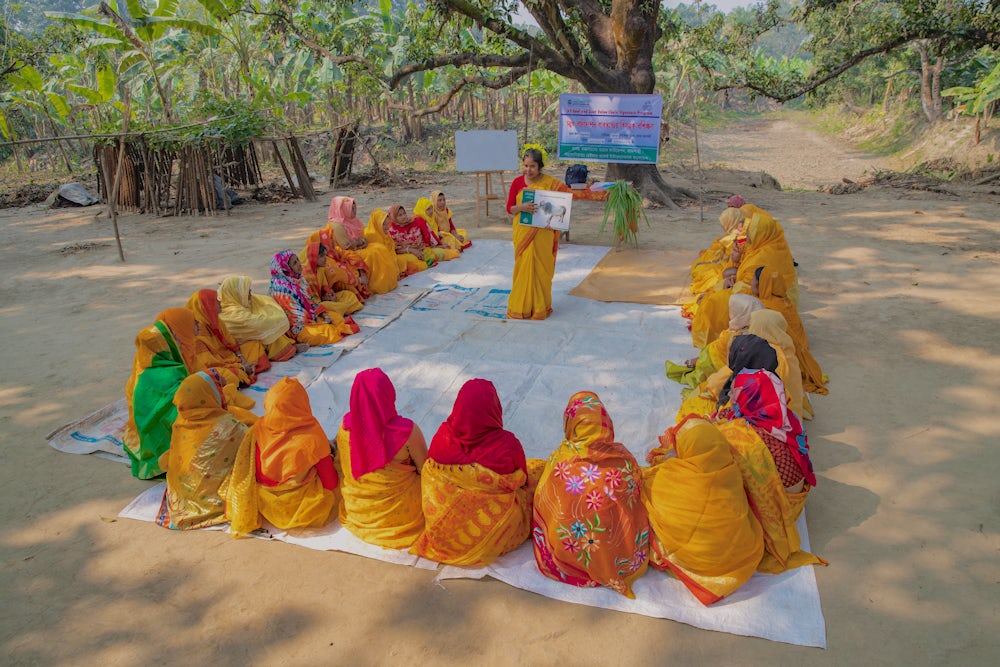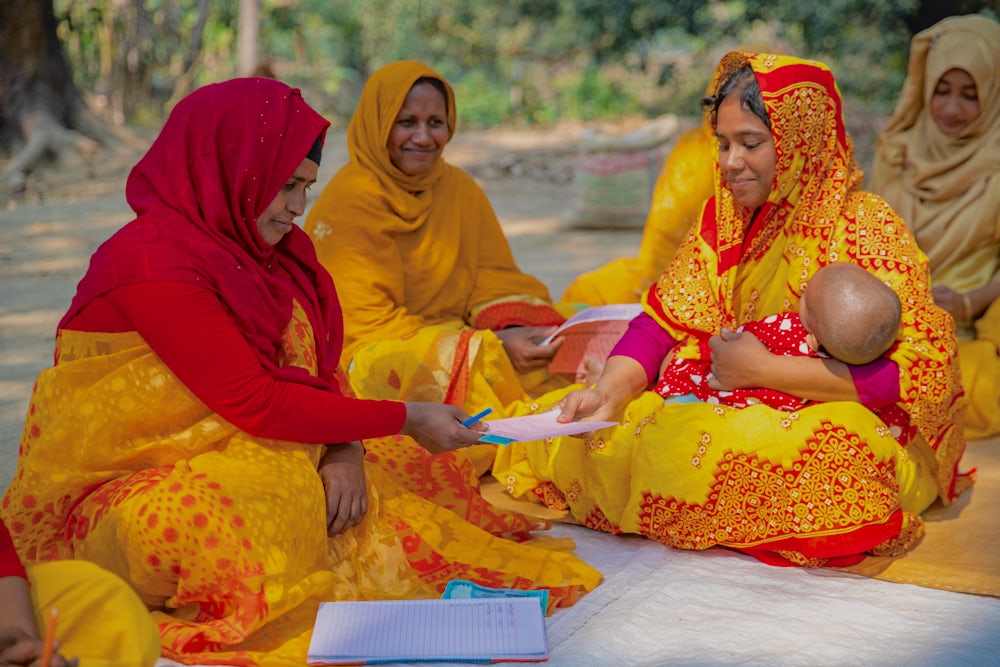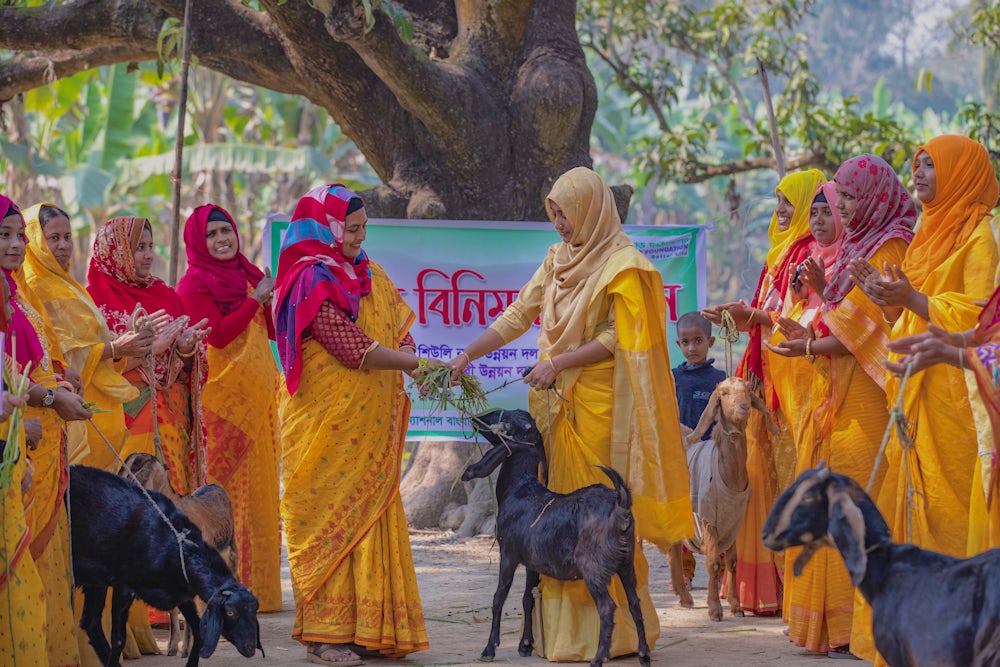Every week — after expeditiously attending to their morning household and farm chores — the members of Gazor Nari Unnayan Dal, a women’s self-help group in Rajshahi village, Bangladesh, collect their savings ledgers and step out of their houses. Clad in bright yellow — a color symbolizing hope — they assemble to fight against poverty and hunger, together.
According to the World Bank’s Poverty and Shared Prosperity Report 2022, approximately 628 million people around the world live in extreme poverty — a consequence of numerous social, economic, cultural and political factors that limit individuals’ access to resources and opportunities and inhibit their capacity to thrive.
In vulnerable and marginalized communities, self-help groups like Gazor Nari Unnayan Dal are a medium through which people can leverage the power of the collective to address these issues, understanding that when individuals unite and pool their strengths and assets, the combined economic and intellectual wealth of the collective empowers each of its constituents.

A self-help group is a community-based peer association made up of 15-25 members from similar socioeconomic backgrounds who often share common interests, goals and challenges. Establishing self-help groups is a development model that facilitates skill-building and forming group-level saving and loan funds in areas where education, livelihoods and social systems are limited. The group structure also builds social capital, encouraging members to identify shared values and principles and work in solidarity toward achieving common objectives, such as self-reliance, economic security and social empowerment.
“As an individual, l am alone, but when I go to the self-help group … I come across other women like me,” shared Marzan Khatun, a smallholder farmer and a member of a self-help group in Rajshahi. “We meet and discuss many things and we learn from each other.”
Worldwide, self-help groups have emerged as powerful catalysts for change. Utilizing local knowledge and resources, self-help groups are at the forefront of leading locally-led development for social change. They allow individuals to come together, support one another and create their own opportunities for personal growth and socioeconomic transformation.
“Using self-help groups as a platform, we are using the collective wisdom of the group to identify the key challenges and the design pathways that they are willing to walk,” explained Subrata Chowdhury, senior manager of institutional development and training for Heifer Bangladesh. “So, this way, we are the advisors, but they are the true decision-makers.”

Self-help groups promote economic security by facilitating group-powered savings and credit, paired with business and technical training — resources especially critical for women and marginalized populations with limited access to formal financing and livelihood support.
“When I became a member of my self-help group, I got the opportunity to save money,” Marzan shared. “Earlier I neither had the opportunity, nor the platform.”
Each member of a self-help group deposits a small amount of money to the group’s collective savings fund on a weekly or monthly basis. These contributions — a set amount that can be offered without compromising basic needs, sometimes less than a dollar per member — become a bank of hundreds of dollars over a few months.
This reserve allows the group to provide small loans to its members at a low interest rate and flexible repayment period, providing financing for individuals to start microenterprises, make investments in their farms, such as purchasing seeds and farm equipment, or bear urgent household expenses such as school fees and medical bills.
The group fund also provides a pathway to the organized financial ecosystem, building financial literacy and preparing group members to open savings accounts in banks and access subsidies, government support and formal loans.

The groups work in communities often fractured by social bias, where distrust may be high, and where resources for individuals to drive their own progress are inadequate. Self-help group support community development by bringing people together for discussion and exercises that build alliances, challenge prejudices, encourage shared wealth generation and promote social cohesion.
Self-help groups are also central in helping individuals develop their interpersonal skills and awareness of self-worth.
Members choose their leaders, such as the president, secretary and treasurer, who lead the group, manage its funds, organize learning activities and resolve conflicts via mutual discussions and dialogues. The position changes faces every few months, allowing all members to take up positions of responsibility and develop their leadership skills.
“There are lots of good changes that I have seen at the community level. Women have more self-confidence,” shared Riya Sheikh, a Heifer-trained community facilitator. “[Earlier] they did not have a voice. … Now, they go on to express their opinions strongly.”
By improving people’s capabilities, questioning their prejudices and addressing socioeconomic challenges, self-help groups contribute to economic growth and poverty alleviation — at scale. Through collective action — and equipped with skills and vision — these groups drive transformation at the community level and can go on to influence local policy, advocacy and development efforts.
Forming self-help groups is a foundation of Heifer’s sustainable locally-led development approach. Our work in smallholder farming communities encourages individuals to form self-help groups in which they can build business knowledge and work together with other producers from their area.
Once a self-help group is formed, the members’ journey together starts with building a clear vision of their goals and aspirations. Conceptualizing a thriving agribusiness and resilient family provides people the trajectory — and resolution — to fulfill their ambitions, together.
Heifer educates community trainers to advance each group’s journey and provide training on the savings and loan functions, effective agricultural production techniques and business development strategies. To ensure active participation, the lessons are customized to the needs of the communities.
“We conduct the training in the language they are comfortable in,” said Riya. “Sometimes it is difficult to explain some concepts due to lack of literacy… so I use a variety of training techniques and materials like picture charts, games and songs so that they can understand and learn.”

Once producers are trained and farm-level productivity has improved, Heifer-supported self-help groups are often legally registered as farmer-led agricultural cooperatives. Driven by values of accountability and solidarity, the cooperatives continue to leverage the power of the collective as a formal enterprise, engaging with large market actors, scaling their businesses, leading social change and spurring progress throughout their communities.
In Bangladesh alone, Heifer is working alongside more than 64,000 women farmers in over 2,500 self-help groups, further federated into 43 farmer-led agricultural cooperatives. Globally, Heifer is supporting millions of farmers through self-help groups that are improving agricultural production, strengthening crop and livestock value chains, establishing profitable rural businesses and trailblazing locally-led social transformation.